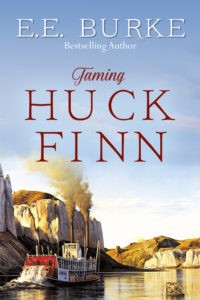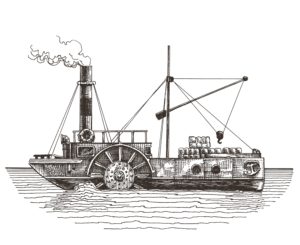When I first sat down to write Tom Sawyer Returns and Taming Huck Finn, I didn’t imagine I would one day be invited to share these stories in the home where Mark Twain penned his original tales.
On Feb. 15, at 7 p.m. Eastern, the Mark Twain House & Museum will present a virtual Valentine’s program, Romancing Mark Twain, and they’ll be featuring my novels. Folks, I am seriously on Cloud Nine!
Through the technological wonder of Crowdcast, I’ll join Director of Interpretation Rebecca Lloyd in a LIVE online discussion about my lifetime love for America’s greatest storyteller, and what drew me to the idea of giving Tom and Huck their own love stories, as well thrilling new adventures.
Better yet…you, dear reader, can join me from the comfort of your own home. You can watch the program online, and, if you’d like, participate in the Q&A.
I can hardly wait! Hope to see you there.
Get your FREE digital tickets at the Mark Twain House & Museum’s online event page: https://bit.ly/RomancingMarkTwain
Chanticleer Reviews gives Tom Sawyer Returns 5 stars/Best Book rating
“Tom Sawyer Returns delivers a Civil War era thriller worthy of its leading characters. Highly recommended!” – Chanticleer Reviews
Full Review
Tom Sawyer Returns is the second book in The New Adventures series by author E.E. Burke.
Readers join a now grown up and far more independent Becky Thatcher as she maneuvers her complicated life in Civil War era Mississippi. Tom has long since left, and Becky is engaged to Union Captain Alfred Temple, who offers her all the safety and security she needs in such uncertain times. But does she love him? Actually love him?
Becky soon discovers that her heart may have other plans.
When an injured Tom Sawyer bursts through her door and collapses onto the kitchen floor, Becky and her father – Judge Thatcher – take him in, care for him, and find out that he may have stumbled into the house for reasons more than the simple rekindling of a lost flame. With Judge Thatcher caught up in a twisted ploy posed by the rebels, Becky must partner up with Tom in order to save her father. But with Tom’s memories nowhere to be found, and his aptitude for ending up smack dab in the middle of trouble, the two find themselves venturing down a twisting road of discovery, mystery, and uncertainty.
Set in a divided world rife with danger and history, E.E. Burke takes characters so close to the heart of Americana and gives them new life.
Fans of Mark Twain’s original work will appreciate the attention to detail and the care in which the story is crafted, paying homage to the original tales of Tom Sawyer and his wild adventures. But this continuation sees a deeper, more intimate portrait of Becky Thatcher – a girl grown into a woman, who’s come into her own confidence and whose sharp mind sees her through many perilous situations.
While the title of the book may be Tom Sawyer Returns, don’t let that fool you – Becky Thatcher is the heart of this book, the backbone, the brains.
Both her and Tom have grown significantly since their childhood days, and Burke expertly takes two kids written nearly 150 years ago and turns them into adults whose life experiences have been shaped by the Civil War; two individuals who are fiercely independent, yet whose attitudes and opinions have been molded by the world they live in. They jump off the page as not simply characters, but as fully realized people. People with complexities, fears, and failures.
Not only does Tom Sawyer Returns take the reader on an adventurous ride filled with plots and ploys, but it also provides a beautiful romance that blooms amidst the thorns of trouble.
E.E. Burke writes with a balance of delicacy and sharpness, showing the true nature of love – that it is something tangled and complicated. As the reader follows Becky and Tom, they’re never made to doubt the pair’s attraction, but to instead find comfort knowing that while their combined history may complicate their feelings for each other, love will still prevail in end. As it always does, and as it always will continue to do.
Tom Sawyer Returns comes in as a 5-star Readers’ Favorite
Tom Sawyer Returns by E.E. Burke was a wonderful reuniting of Tom and Becky Thatcher. I was hooked from the first word until the very last. There were so many things going on at once and I kept changing my mind about who was the good guy and who was bad, though I have to admit I couldn’t help but root for Tom. I love the style in which E.E. Burke told the story of a grown-up Tom and Becky. The story brought back happy hours of my youthful reading and presented a new Tom and Becky for me to enjoy in my older years. Tom Sawyer Returns is a wonderful book for young and old, male and female. This is a top-notch book that deserves lots of praise. ~ Trudi LoPreto for Readers’ Favorite
As we roll into a new year, I want to say “thank you!” I think all of you deserve a 5-star rating for being the best readers in the world.
E.E. Burke




 Where Tom’s story is an action-adventure, Huck’s story is a journey. Throw in one young orphan who idolizes his famous uncle and a spinster who is determined to civilize them, and you have a recipe for Huck’s greatest challenge.
Where Tom’s story is an action-adventure, Huck’s story is a journey. Throw in one young orphan who idolizes his famous uncle and a spinster who is determined to civilize them, and you have a recipe for Huck’s greatest challenge. Embark on a new adventure with an old friend
Embark on a new adventure with an old friend In those days, it took nerves of steel to pilot a steamboat on the wild, untamed Missouri River. A few of the things steamboat pilots encountered: elusive, ill-defined and ever-changing channels, getting stranded in low water, innumerable and often invisible snags, whirlpools, Indian attacks–to name but a few.
In those days, it took nerves of steel to pilot a steamboat on the wild, untamed Missouri River. A few of the things steamboat pilots encountered: elusive, ill-defined and ever-changing channels, getting stranded in low water, innumerable and often invisible snags, whirlpools, Indian attacks–to name but a few. Near Kansas City, a construction company dug up a steamboat from the 1850s out of a farm field (the river had long since changed course). While there were no human casualties, the boat went down with its entire load of supplies. The
Near Kansas City, a construction company dug up a steamboat from the 1850s out of a farm field (the river had long since changed course). While there were no human casualties, the boat went down with its entire load of supplies. The 






